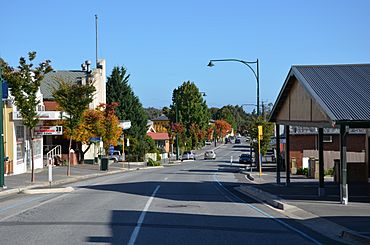Lobethal facts for kids
Quick facts for kids LobethalSouth Australia |
|||||||||||||||
|---|---|---|---|---|---|---|---|---|---|---|---|---|---|---|---|

Main Street, Lobethal
|
|||||||||||||||
| Established | 1842 | ||||||||||||||
| Postcode(s) | 5241 | ||||||||||||||
| Location | 42 km (26 mi) from Adelaide | ||||||||||||||
| LGA(s) | Adelaide Hills Council | ||||||||||||||
| State electorate(s) | Morialta | ||||||||||||||
| Federal Division(s) | Mayo | ||||||||||||||
|
|||||||||||||||
Lobethal is a town in the Adelaide Hills area of South Australia. It's part of the Adelaide Hills Council and sits by a creek, surrounded by hills. Long ago, it was a big center for making wool products. This continued until about 1950. Now, the old mill buildings are home to many small businesses that make handmade goods. In 2016, about 2,135 people lived in Lobethal.
The town is very famous during the Christmas season. People from all over the state come to see its amazing Christmas lights and decorations. This tradition started in the 1950s.
Contents
History of Lobethal
Lobethal was started in 1842 by people from Prussia. They came to South Australia with a pastor named Gotthard Fritzsche. They first went to Hahndorf but then found good land in the upper Onkaparinga area. German Lutheran settlers bought land to create their community.
The name "Lobethal" comes from German and means "valley of praise". It was named after a Bible verse from the Book of Chronicles.
The town was built in a special style called Hufendorf. This meant cottages were in a line along the main street. Each family had a long, narrow piece of land behind their house for growing crops. All families shared a common area where their animals could graze. This layout made sure everyone had access to water and the main road. Even though the town has grown a lot, you can still see parts of this old design.
In 1845, the first Lutheran church building in Australia, St John's, was built here. A newer church stands next to it today. Many of the early settlers' traditions are still celebrated.
Around 1850, a brewery opened in Lobethal. It later closed and became the Lobethal Tweed Factory. This factory grew into the Onkaparinga Woollen Company, which made wool products until 1992. A factory that made cricket bats from local willow trees also operated from 1894 to 1950.
During World War I, in 1917, the South Australian government changed many German place names. Lobethal was renamed Tweedvale to honor its wool industry. But in 1935, the name Lobethal was given back to the town.
Geography and Climate
Lobethal is located between Gumeracha and Woodside. You can reach it from Adelaide by driving through Magill and Norton Summit.
Weather in Lobethal
Lobethal has a climate with warm summers. This is known as a Mediterranean climate. It means summers are warm and dry, and winters are mild and wet.
| Climate data for Lobethal | |||||||||||||
|---|---|---|---|---|---|---|---|---|---|---|---|---|---|
| Month | Jan | Feb | Mar | Apr | May | Jun | Jul | Aug | Sep | Oct | Nov | Dec | Year |
| Mean daily maximum °C (°F) | 25.0 (77.0) |
26.0 (78.8) |
23.0 (73.4) |
19.0 (66.2) |
15.0 (59.0) |
12.0 (53.6) |
11.0 (51.8) |
13.0 (55.4) |
15.0 (59.0) |
18.0 (64.4) |
21.0 (69.8) |
23.0 (73.4) |
18.4 (65.1) |
| Daily mean °C (°F) | 19.0 (66.2) |
20.0 (68.0) |
17.5 (63.5) |
14.5 (58.1) |
12.0 (53.6) |
9.5 (49.1) |
8.5 (47.3) |
9.5 (49.1) |
11.0 (51.8) |
13.0 (55.4) |
15.5 (59.9) |
17.5 (63.5) |
14.0 (57.1) |
| Mean daily minimum °C (°F) | 13.0 (55.4) |
14.0 (57.2) |
12.0 (53.6) |
10.0 (50.0) |
9.0 (48.2) |
7.0 (44.6) |
6.0 (42.8) |
6.0 (42.8) |
7.0 (44.6) |
8.0 (46.4) |
10.0 (50.0) |
12.0 (53.6) |
9.5 (49.1) |
| Average rainfall mm (inches) | 25.3 (1.00) |
19.2 (0.76) |
33.9 (1.33) |
56.8 (2.24) |
90.5 (3.56) |
117.3 (4.62) |
138.4 (5.45) |
120.5 (4.74) |
100.4 (3.95) |
63.4 (2.50) |
37.8 (1.49) |
36.5 (1.44) |
840 (33.08) |
| Average rainy days | 3 | 2 | 3 | 6 | 9 | 12 | 13 | 13 | 10 | 7 | 4 | 4 | 86 |
| Source: NOAA. | |||||||||||||
Things to See and Do
Lobethal has two hotels and two primary schools. It also has a Country Fire Service station.
You can visit the Lutheran Church complex and the Archives and Historical Museum. They have lots of information about the lives of the German settlers. These places are open all year.
The Lobethal Bierhaus is a local brewery. It makes different kinds of beers. The Lobethal Bakery offers many German-style breads and cakes.
In the old woollen mill building, you'll find many small businesses. They create unique handmade products. The area around Lobethal also has many wineries where you can taste local wines.
Culture and Traditions
Lobethal is well-known for its amazing Christmas lights display. Every December, the main streets and many homes are decorated with bright lights. This tradition started in the 1950s and is the biggest Christmas display in South Australia. Sadly, in 2019, the events were cancelled because of large bush fires that caused a lot of damage nearby.
The area is also becoming famous for its many local food and drink producers.
Getting Around
Adelaide Metro buses serve Lobethal. You can take buses from Lobethal to the center of Adelaide. There are also buses that go to Verdun Junction and Mount Barker.
Motorsport History
Lobethal was once the host town for a very important car race. This was the 1939 Australian Grand Prix, Australia's top motor race that year. The race took place on the Lobethal Circuit, which used public roads in and around the town. This circuit was used for four race events between 1937 and 1948.
Images for kids



